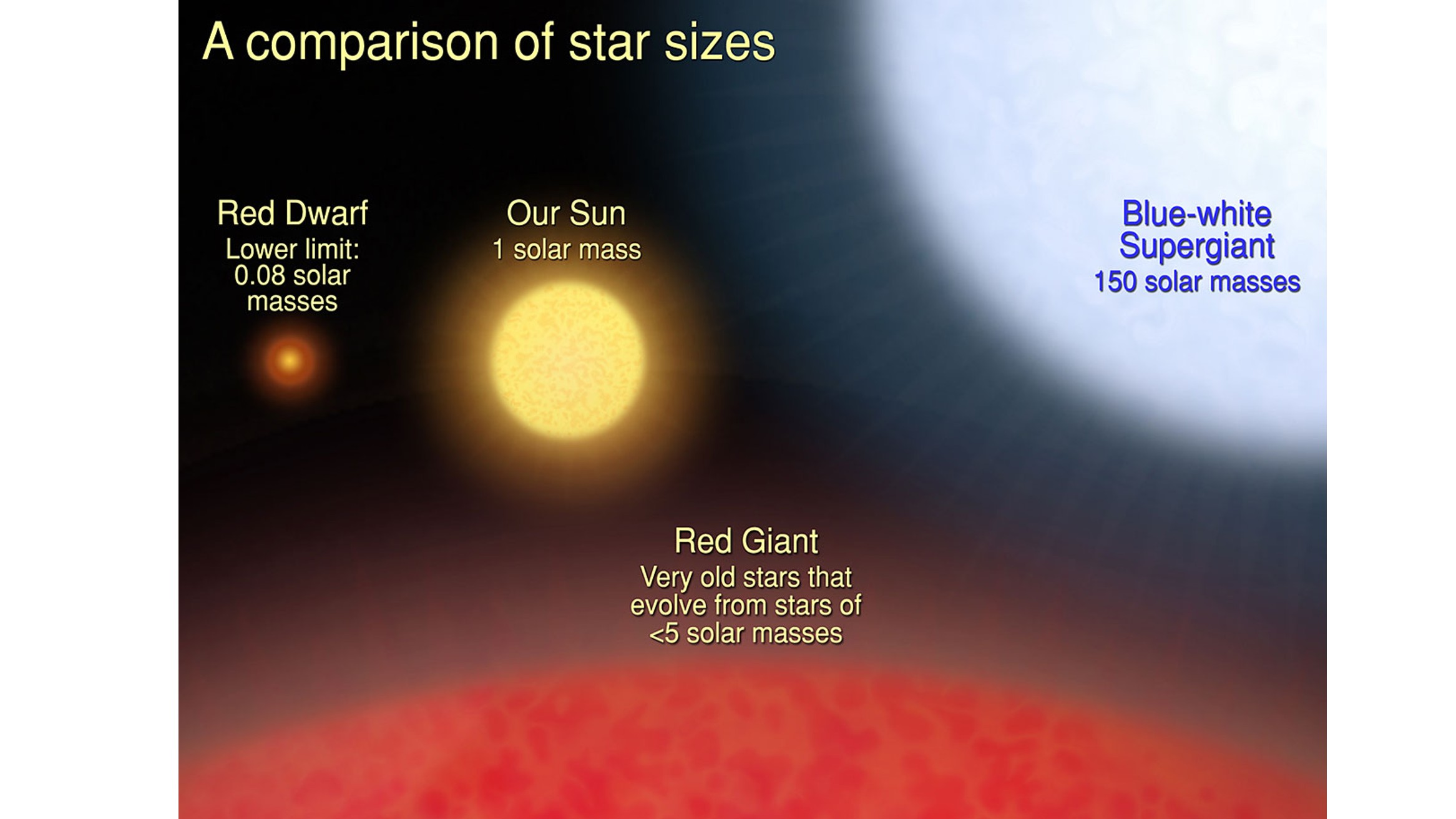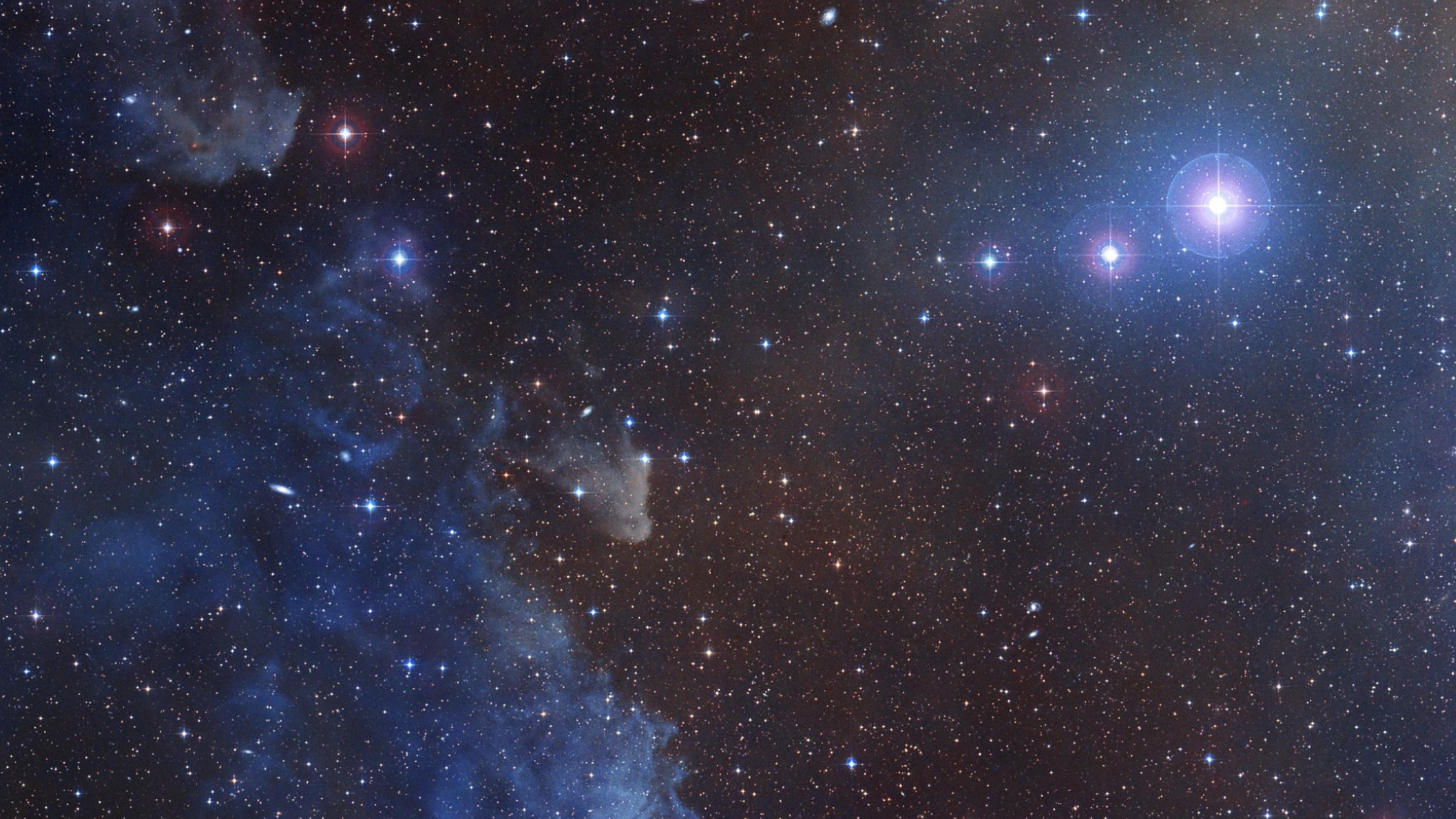Blue stars are by far the biggest and brightest stars in the galaxy.
To the naked eye, the stars in the night sky all look very similar to each other, the main difference between them being that some are brighter than others. But if you look more carefully, you’ll see that stars come in different colors.
Most of them look white, but some are distinctly red in color while others are blue. A star’s color tells us about its temperature and mass, and blue stars are the hottest and most massive of all.
Any star that has three or more times as much mass as the sun will tend to look blue to our eyes. That’s irrespective of other factors such as chemical composition; blue stars, yellow stars and red stars alike are made up of around 75% hydrogen, 24% helium and smaller amounts of other elements. But the fact that blue stars are more massive means they generally have higher intrinsic luminosities than other stars. This means they can be a long way away and still remain visible in the sky.
Related: How many stars are in the universe?
Why are blue stars so hot?
Blue stars are blue because they’re very hot. This sounds wrong, because in the everyday world — for example on weather maps — red means hot and blue means cold. But blue light carries more energy than red light, which means it needs a hotter radiation source to produce it. This explains why blue stars are hotter than red stars, and also has a down-to-earth consequence if you’ve ever seen metal being heated up in a forge. First, it glows red, then as it gets hotter it turns blue-white.
The high temperature of blue stars, coupled with their high luminosity, means that they’re constantly blasting out huge amounts of energy into space. As a consequence they burn through all their fuel very quickly, making them the shortest lived of all stars. For this reason, blue stars are most often observed near to the star-forming regions where they were born.
(opens in new tab)
Although star-forming regions produce stars with a range of masses, they’re not created in equal numbers, with low-mass stars vastly outnumbering high-mass ones. Coupled with the short lifetimes of the latter, this means blue stars tend to be scarce. Even so, we see quite a lot of them in the night sky, because the ones that do exist are so luminous.
To mention just three well-known blue stars, there’s Regulus, the brightest star in the constellation Leo, Spica, the brightest star in Virgo and Rigel, the brightest in Orion.
As seen from Earth, all three stars appear similar in brightness, even though they’re located at very different distances from us: 79, 250 and 860 light-years respectively. This reflects the fact that blue stars come in different types — Regulus is a main sequence star, Spica a blue giant and Rigel a blue supergiant — depending on where they are in their evolutionary life cycle.
However, the most massive star observed to date is the blue supergiant R136a1, which contains at least 265 times as much matter as the sun.
What is the life cycle of a blue star?
All stars go through life cycles, changing their appearance and behavior on a timescale much too slow for us to observe directly. Most of the stars we see are in the ‘main sequence’ phase of their evolution, in which they convert hydrogen into helium through nuclear fusion. The amount of time they spend in this phase, and what happens afterward, depends on the star’s mass.
The highest mass stars, greater than three times the sun’s mass, appear blue in color when they’re on the main sequence, and they get through all their hydrogen fuel more quickly than lower mass stars.

(opens in new tab)
As a blue star nears the end of the hydrogen-burning phase, it enters a relatively brief transitional state as a higher-luminosity blue giant. As it progresses through this phase, the core temperature steadily rises until it’s high enough to trigger the fusion of helium into heavier elements such as carbon and oxygen. This causes the star to enter an even brighter phase as a blue supergiant. These stars have truly enormous luminosities; for example, the blue supergiant Rigel emits 60,000 times as much energy as the sun.
We’ve seen that blue stars are blue because they’re very hot, and that their high temperature means they burn fuel much faster than other stars. So the fact that they started out with a limited supply of fuel suggests we should never see any ‘old blue stars’.
Yet such stars, known as ‘blue stragglers’, do in fact exist. These are hot, blue stars that are still in the main sequence even though they’re located in star clusters that we know to be very old. The most likely explanation is that blue stragglers are old, red stars that have been rejuvenated by new material falling into them from a binary companion.
What are giant blue stars?

(opens in new tab)
The basic definition of a ‘giant’ star is one that is more luminous than a main sequence star. As the name suggests, part of the reason for this is simply that such stars are enormous in size. That’s particularly true of the commonest kind of giant stars, the red giants.
Most stars, including the sun, will eventually end up as red giants, and that’s the case with blue stars too. Earlier in their lives, however, the latter will have spent time as blue giants and supergiants, and these are ‘giants’ due as much to the huge amount of energy they radiate as to their physical size.
Rigel, for example, a blue supergiant in the constellation of Orion, is only 79 times the diameter of the sun, compared to more than 550 times in the case of the red supergiant Betelgeuse in the same constellation.
Additional information
For more information about the physics of stars and their differences check out “Stars and Stellar Processes (opens in new tab)” by Mike Guidry and “Secret Life of Stars: Astrophysics for Everyone (opens in new tab)” by Lisa Harvey-Smith.
Bibliography
University of Neva, “Star Formation (opens in new tab)“, accessed September 2022.
Swinburne University of Technology, “Stellar Evolution (opens in new tab)“, accessed September 2022.
University of Leicester, “Stars (opens in new tab)“, accessed September 2022.
NASA, “Blue Straggler Stars in Globular Cluster M53 (opens in new tab)“, February 2021.
Todd Thompson, “Astronomy 1101 — Planets to Cosmos (opens in new tab)“, The Ohio State University, accessed September 2022.
Cornell University, “What are “blue stragglers” in globular clusters? (Intermediate) (opens in new tab)“, June 2015.
David Darling, “Blue Giant (opens in new tab)“, accessed September 2022.
Bruce Dorminey, “Why does the universe make so many tiny stars? (opens in new tab)“, Astronomy, January 2019.
Deborah Byrd, “Spica, bright beacon of Virgo, is 2 stars (opens in new tab)“, EarthSky, July 2021
Universe Today, “Blue Stars (opens in new tab)“, accessed September 2022.
Stephen Luntz, “Blue Really Is The Warmest Color (opens in new tab)“, Insider, July 2014.
Jen Gupta, “Why are some stars red and some stars blue? (opens in new tab)“, Sky at Night, March 2022.

